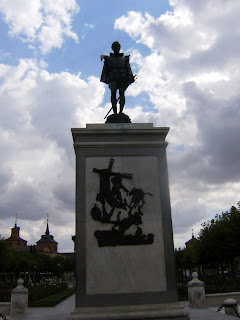Many of the drinks of choice are similar to those of Madrid’s: calimochi (red wine mixed with coca-cola), tinto de verano (“red wine of summer” or red wine mixed with sugar and lemon (or as most places do it now, red wine mixed with lemon Fanta)), sangria (red wine mixed with brandy, sugar, and various fruits), cerveza con límon (beer mixed with lemon Fanta), among a small assortment of beers and chilled red wine. The south of Spain, however, is also known for their sherry. They have several popular kinds. We stuck to ordering vino fino, a light, dry white sherry. Once we figured out what we liked, we specifically ordered Manzanilla, which was the driest in our opinion. I have nothing bad to say about these delicious beverages except occasionally one might find a brand that leans to the sweet side. Craig’s student’s, however, insisted that we were CRAZY to drink straight sherry and that it should, of course, be blended with Sprite. I’ve had enough of diluted wine, thankyouverymuch!!!
The first day, we missed lunch. When dinner time finally rolled around about 9:00, I was studying the tour guide’s guide to culinary treasures and was literally salivating at the pictures. The most appealing photo was that of a nice looking stew. Beef, I thought, I need beef!! Upon further reading I found it was ropo de toro, or bull’s tail. Being naïve and enormously hungry, I assumed this was a figurative label, a fun nickname in reference to the Spanish passion for bulls. Three large chunks of meat in sauce were set before us. The first bite was SPECTACULAR! It was similar to pot roast in taste and texture; the meat simply fell off the bone. The, er, pieces of spine, actually. I quickly realized that bull’s tail is not simply a superfluous title. Although I truly enjoyed it, I must admit that after some time of pulling the muscle off the vertebrae my back and my stomach began to hurt.

As an avid olive-lover, I have been searching for the perfect olive in this olive-populated country. As of yet, I have not discovered a single olive that I like. I must emphasize, before coming to Spain, I had never met an olive that I DIDN’T love. The olives (and pickles) here tend to be flavored with anchovies and something I cannot place that is meant to be barbeque flavor. I tried many more in Sevilla, but I sadly admit that the olive quest continues.
We sampled what Craig declared as the best napolitanas Spain has to offer at La Compana, the café we haunted each morning for cafés con leche. Craig is particularly infatuated with these sweet pastries. They are similar to the French “pain chocolate” and are essentially a croissant-like pastry rolled around or injected with chocolate sauce.
We refreshed our palates with a good old-fashioned Budweiser when we wandered by a welcome sign that read: SEC Championship Alabama vs. Florida! The Texas Lone Star Bar, so it was proclaimed, welcomed us with open arms and we chatted with Florida fans and watched Spaniards eat cheeseburgers the size of dinner plates. It is a strange feeling, sitting in the south of Spain in a pub at three in the morning, listening to a mixture of languages buzzing around you and watching, of all things, American college football. Despite the fun of it, it was a sad night for Alabamians!
After two days of goat-cheese-stuffed-mushroom tapas, pan con tomate, sole with belle femme sauce, patatas ali-oli, fresh-squeezed orange juice,
 good coffee and wine, the straw that broke the camel’s back proved to be Adobo Sevillana, which, the waiter told us, is fried fish. Indeed. The entire fish, specifically, bones, skin, etc, cut in chunks, tossed in meal and fried. This was actually quite delicious, but difficult to eat if you don’t want to swallow the entire skeletal system. Thus, I only partook in only a partial portion.
good coffee and wine, the straw that broke the camel’s back proved to be Adobo Sevillana, which, the waiter told us, is fried fish. Indeed. The entire fish, specifically, bones, skin, etc, cut in chunks, tossed in meal and fried. This was actually quite delicious, but difficult to eat if you don’t want to swallow the entire skeletal system. Thus, I only partook in only a partial portion.  This is what saved me, I believe, from the bout of food poisoning-ish flu Craig woke up with the next morning. The paella and sangria were skipped as we instead sipped 7-Up and made our way back to the bus station for a lunch of potato chips and dried nuts.
This is what saved me, I believe, from the bout of food poisoning-ish flu Craig woke up with the next morning. The paella and sangria were skipped as we instead sipped 7-Up and made our way back to the bus station for a lunch of potato chips and dried nuts.All in all we did not run into many vegetables and the pork was still #1 on the menu every time. But it was refreshing to snack on seafood that isn't fried calamari rings or the octopus that is so beloved in Madrid. I can't wait to return south and continue my gastronomical exploration!



























